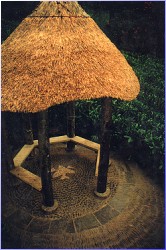Landscaping
 We have huge unusual granite rocks suitable for megaliths, or a boulder strewn stream. We know the methods to move and place such stones, an ancient skill that archaeologist can only speculate about, but diggers can help. Most work is on the small scale of modern houses. More often patios, lawns and shrub borders are catered for, rather than large monuments. We use stone, which is can easily obtained in Cornwall, for walling, paving and mosaics.
We have huge unusual granite rocks suitable for megaliths, or a boulder strewn stream. We know the methods to move and place such stones, an ancient skill that archaeologist can only speculate about, but diggers can help. Most work is on the small scale of modern houses. More often patios, lawns and shrub borders are catered for, rather than large monuments. We use stone, which is can easily obtained in Cornwall, for walling, paving and mosaics.
 Mosaics, constructed in situ, provide a one off decorative piece that is attractive yet functional. The technique is a departure from traditional cobbling for paths with simple design motifs using two or three different coloured stones set into the ground direct. Laid using this method, the stones will last as long as they are maintained, by simple brushing, and will take a great deal of traffic.
Mosaics, constructed in situ, provide a one off decorative piece that is attractive yet functional. The technique is a departure from traditional cobbling for paths with simple design motifs using two or three different coloured stones set into the ground direct. Laid using this method, the stones will last as long as they are maintained, by simple brushing, and will take a great deal of traffic.
In 1996, the centre piece for a National Trust maze was visited by 60,000 people of all ages. The processes for laying a stone mosaic require hand selection of cobble stones from beach and quarry. Sizes and colours are important and skill and patience are the basic ingredients. The scale of the work dictates the size of the stone used.
On the right is a sample sketch of a garden boundary design to maintain privacy. The light weight chestnut panel at the front supports the beautiful Wisteria Floribunda Issai.
